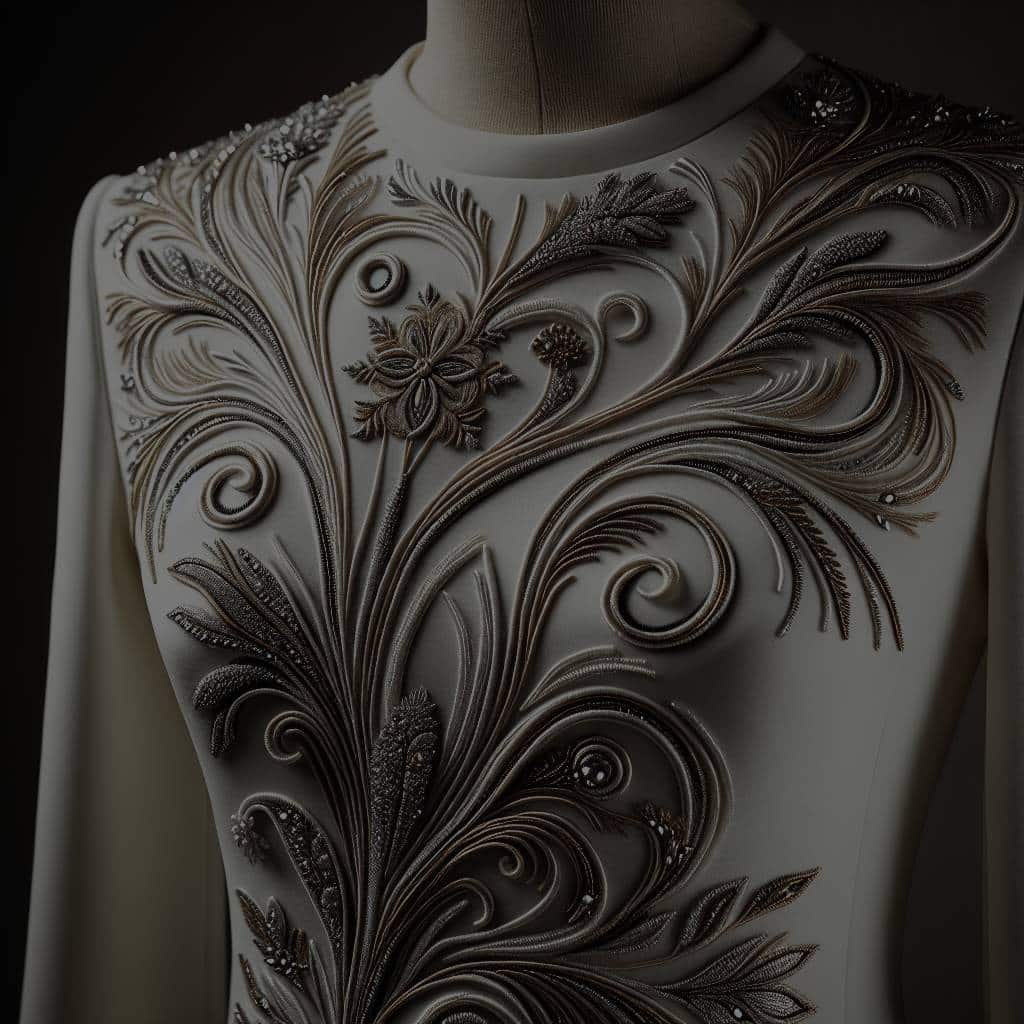What Are the Key Styles for Embellishing a Professional Tunic Top with Elegant Embroidery?

Many of you are already familiar with the delightfully intricate art of embroidery. It is a craft that has stood the test of time, evolving from the hand-stitched designs of centuries past to today’s use of technologically advanced embroidery machines. Embroidery as an art form has continuously reinvented itself, adapting to the changing world around it.
Today, we will delve into the world of embroidery with a particular focus on professional tunic tops. We’ll discuss different techniques to embellish them with elegant embroidery, highlight some key styles, and explore how embroidery machines simplify this exquisite art.
Lire également : How Can You Master the Layering of a Tweed Skirt and Cashmere Sweater for a Traditional British Look?
Selecting the Ideal Fabric and Thread
Choosing the right fabric and thread is foundational to the success of your embroidery work. Remember, the fabric is the canvas upon which you will create your art.
Tunic tops come in a range of materials, from cotton to silk to wool. A fabric’s texture and weight can dramatically affect how your embroidered designs will look and feel. Lighter fabrics like silk or chiffon are delicate, requiring careful handling and smaller, more delicate stitches. Heavier fabrics such as wool or denim can withstand larger, more robust stitches.
A lire en complément : What Are the Most Stylish and Practical Heeled Oxfords for Walking to Work?
When it comes to selecting your thread, you have an array of choices. The traditional choice is embroidery thread, which is a special thread specifically designed for embroidery. It is available in a variety of colors and textures, including metallic, variegated, and glow-in-the-dark. Your thread choice can dramatically affect your design’s final look, so think about what you want your design to convey and let that guide your decision.
Embroidery Techniques
Using the correct technique is crucial in creating a design that not only looks good but also lasts. With countless embroidery techniques available, it’s essential to select the ones that best suit your design and fabric.
Hand Embroidery techniques often call for a hoop to keep the fabric taut. This tool ensures even stitches and helps prevent fabric puckering. Some popular hand embroidery stitches include running stitch, back stitch, and satin stitch.
However, for a professional tunic top, you might want to consider Machine Embroidery. This method allows for consistent, precise stitches that can recreate complex designs with ease. The two main techniques in machine embroidery are free-motion and computerized. Free-motion embroidery allows you to move the fabric freely under the machine’s needle, creating fluid, artistic designs. Computerized embroidery, on the other hand, uses pre-programmed design patterns, perfect for replicating intricate designs accurately and efficiently.
Embroidery Design
The design you select for your embroidery is what will make your shirt truly unique. It’s your chance to express your personal style or even communicate a message.
When choosing a design, consider the shirt’s purpose and the wearer’s preferences. If it’s a professional tunic top, you might want to keep the design subtle and elegant. Smaller, intricate designs can add a touch of sophistication without being too overbearing.
Remember, the design doesn’t always have to be a traditional pattern or image. Why not consider a monogram or a meaningful word? Embroidered letters can add a personal touch to any shirt, and they never go out of style.
Custom Embroidery
If you’re looking to make your shirts truly unique and personal, consider custom embroidery. This could mean creating your own design or having your designs professionally digitized for machine embroidery.
In today’s digital age, custom designs are more accessible than ever. There are software applications available that allow you to create your own embroidery designs. These will enable you to play with different stitches and colors until you’ve created the perfect design for your shirt.
The Role of Embroidery Machines
Embroidery machines have revolutionized the art of embroidery, making it quicker and easier than ever before to create intricate designs on fabric. With the help of these machines, you can recreate designs perfectly every time, and on multiple shirts if you wish.
These machines allow you to take a digital image and transform it into an embroidery design. This opens up a world of possibilities for your designs. You could take a photograph and recreate it in thread, or take a drawing and transform it into a work of embroidered art.
Embroidery machines also save time by automating the stitching process. You can set the machine to work on your design and then turn your attention to other tasks. This is especially beneficial if you’re working on a large project or producing multiple embroidered shirts.
Embroidery is an art form that has been around for centuries, evolving with each new generation. It offers endless possibilities for personal expression and creativity, whether you’re embellishing a professional tunic top or creating a custom design. By choosing the right fabric and thread, mastering your techniques, selecting the perfect design, and utilizing the power of an embroidery machine, you can take part in this timeless tradition and create your own masterpieces.
The Evolution of Embroidery Styles: From Early Century to the Present
Embroidery has a rich history, dating back to early centuries and evolving over time to adapt to technological advancements and stylistic changes in fashion. In this section, we will delve into the evolution of embroidery styles.
Embroidery styles from the early centuries were predominantly performed by hand, with techniques such as cross stitch and canvas work being popular choices. The Victoria Albert Museum houses some exquisite examples of these early works, showcasing intricate designs created by talented craftsmen and women meticulously stitching with silk thread.
As we moved into the modern era, technological advancements began to shape the art of embroidery. The invention of the embroidery machine in the 19th century heralded a new era for this craft. Machine embroidery allowed for faster production, more intricate designs, and a level of consistency that could not be achieved by hand.
Today, both hand embroidery and machine embroidery continue to be used, often in combination, to produce stunning effects. Modern day embroidery offers a vast range of styles and techniques, from traditional counted thread work to contemporary screen printing designs on custom shirts.
In the realm of professional tunic tops, embroidery serves to add a touch of unique elegance. The versatility of embroidery allows for endless possibilities, from subtle shirt remakes with delicate motifs to bold, custom printed designs that make a statement.
Strategies for Embroidery Digitizing and Printing
In today’s digital age, the use of embroidery digitizing software and shirt printing machines has made custom shirt design more accessible than ever. These tools offer endless opportunities for creativity and innovation.
Embroidery digitizing involves converting a digital image into a format that an embroidery machine can read. This means you can take any image, perhaps a hand-drawn design or a photograph, and transform it into an embroidery design that can be stitched onto your shirt.
This process opens up a world of opportunities – you can create one-of-a-kind embroidered shirts that truly reflect your personal style or message. The final outcome is only limited by your imagination. Whether it’s a beautiful floral pattern, your company’s logo, or a memorable quote, digitizing allows you to bring your ideas to life.
Shirt printing, on the other hand, uses a machine to apply ink directly onto the fabric. This process can be used to create vibrant, custom printed shirts with intricate designs that wouldn’t be possible with traditional embroidery techniques.
When it comes to professional tunic tops, embroidery digitizing and shirt printing offer various ways to add a unique touch. Whether it’s a subtle logo embroidered onto the chest or a bold, all-over print, these techniques allow you to create a shirt that’s truly one-of-a-kind.
Conclusion: Embrace the Art of Embroidery
Embroidery, whether by hand or machine, is a fantastic way to add a personal touch to any garment. With the right materials, a vivid imagination, and a little patience, you can transform a simple shirt into a stunning piece of wearable art.
Whether you’re a fan of the meticulous detail of hand embroidery or you prefer the precision and consistency of machine embroidery, there’s a technique to suit your style. From traditional cross stitch or counted thread work to modern embroidery digitizing and shirt printing, the world of embroidery offers endless possibilities.
So why not give it a go? The next time you’re looking to update your professional tunic top, consider adding some embroidery. It’s a great way to express your personal style, create a unique garment, and partake in a craft that’s been loved for centuries. Who knows? You might just create your next masterpiece.
